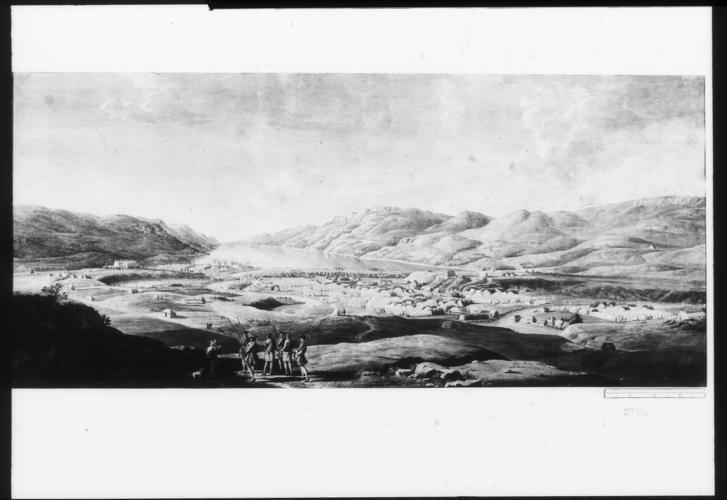Fort Augustus c. 1746
Pen and ink and watercolour | 31.7 x 70.1 cm (sheet of paper) | RCIN 914725
-
A watercolour view of Fort Augustus, with many rows of tents. A loch and mountains in the distance. In the foreground, a group of soldiers with two Jacobite prisoners, and a woman and child. Inscribed on the mount in pencil, 'by Sandby' in the same hand as on 914723 and 914724. The price £2.2.0 on the verso enables this to be identified as a drawing bought at the same time as 914724. On the back of the paper mount, a rough architectural sketch in pen and ink and wash of a building and colonnade.
Thomas Sandby trained as a military draughtsman at the Board of Ordnance, and worked for three years at their drawing room in Edinburgh before entering the employ of William Augustus, Duke of Cumberland during his campaign to defeat the Jacobites, concluding with the Battle of Culloden in 1746. An apocryphal anecdote first recorded by the critic John Williams suggests that it was Sandby who 'conveyed the intelligence of the [landing of the Young Pretender] to the Government in the year 1745' (see J. Bonehill and S. Daniels (eds), Paul Sandby: Picturing Britain, exh. cat., Royal Academy etc 2009, p. 78).
Fort Augustus was built by General Wade after the Jacobite Uprising of 1715, who named it after the Duke. The fort was captured by the Jacobites in March 1746, shortly before the Battle of Culloden. The present drawing forms a pair with 914724; a preparatory study for that drawing is 914723. This drawing shows the settlement after the Jacobite defeat, looking down on the ruined fort and the tents set up by the Hanoverian soldiers. Both drawings are more likely to be commemorative than functional field drawings. Bonehill and Daniels have pointed out the significance of the vignette in the foreground, with Jacobite prisoners being led away by Hanoverian soldiers, delayed by a pleading woman and child. The figures in the foreground of the pendant drawing 914724, which looks down on the ruins from further down the slope, are soldiers playing nine-holes explaining the rules to a confused-looking Highlander. These vignettes caricature the Jacobite enemy as both comically stupid, and neglecting their domestic responsibilities in pursit of a futile cause (Picturing Britain, p. 79). Bonehill and Daniels also note that the drawings were probably intended to be engraved as a pair of prints, and the figures are probably attributed to Thomas's younger brother, Paul Sandby, or were copied from his drawings. The group of soldiers appear in a drawing by Paul Sandby at the British Museum (Nn,6.45).Provenance
Thomas Sandby estate sale (Leigh & Sotheby, 18 July 1799; bt Colnaghi); bought by George IV when Prince of Wales by 20 June 1804
-
Creator(s)
Acquirer(s)
-
Medium and techniques
Pen and ink and watercolour
Measurements
31.7 x 70.1 cm (sheet of paper)
Other number(s)
RL 14725









